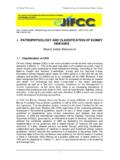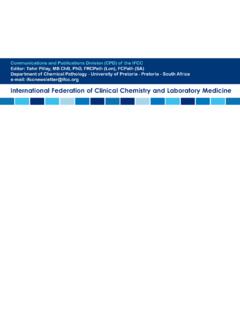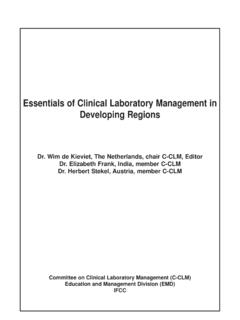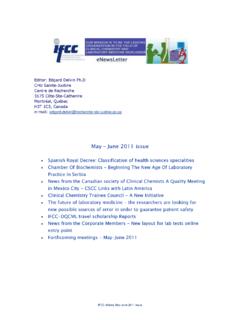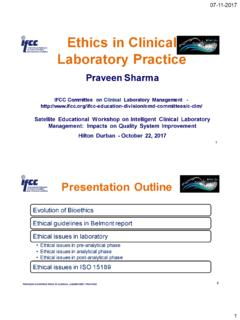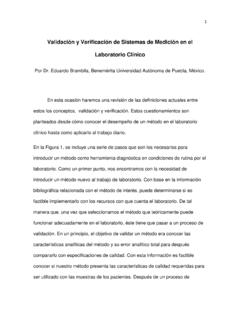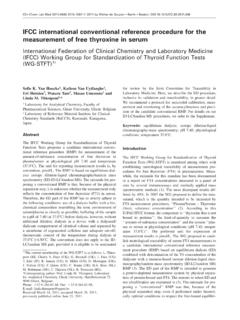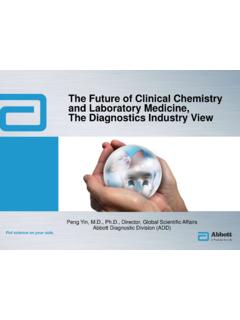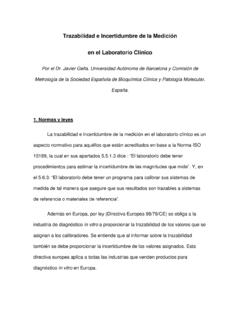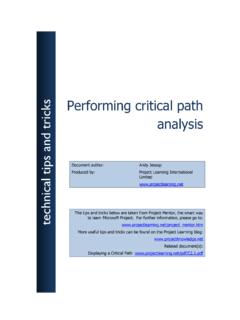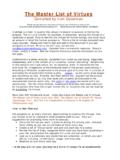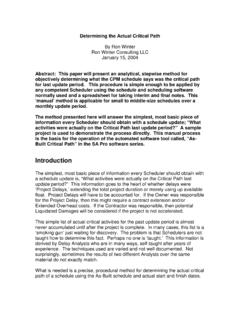Transcription of Critical limits of laboratory results for urgent …
1 Vol 14 No 11eJIFCC: to Cite this article: Critical limits of laboratory results for urgent clinician Notification, eJIFCC vol 14 no 1: limits of laboratoryresults for urgent cliniciannotificationProfessor Dr Lothar ThomasKirschbaumweg 8, 60489 FrankfurtE-mail: limits of laboratory results need urgent notificationto the clinician because they are an indicator of a criticalor even life-threatening condition of the publications about this topic are mainly from the1970s. Since then, many laboratory methods have beenimproved, new parameters have been added, and therehave also been changes in the evaluation and treatment this background and at the request of the Ameri-can Medical Association, Kost [1] conducted a surveyon Critical pa-rameters in the USA in 1990 and Howanitzet al.
2 [2] in 2002. The spectrum of Critical pa-rametersreported in these publications does not meet the require-ments of laboratory medicine in every have therefore put together a new list of qualitative andquantitative parameters. If you think there are parametersthat should perhaps be added or deleted, limits , whichneed changing, or notes that need to be amended, yoursuggestions would be most laboratory test results for the blood andextravascular body fluids are indicators, for example, oforganic disease, metabolic disorders, diseases of thehaematopoietic system, disturbances of haemostasis,abnormalities of the endocrine system, activation orinsufficiency of the immune system, inflammation,infections, and autoimmune detection sensitivity, a wide measurement range, andgood to acceptable precision and accuracy.
3 Allow bloodparameters to be determined in concentration ranges,which indicate that the patient is in acute danger or even adanger to others. The laboratory must report such resultsto the treating physi-cian immediately. For this to happen,there must be an agreement between the treating physicianand the laboratory as to what constitutes a Critical resultthat needs to be reported to him. The parameters chosenand the Critical limits depend essentially on the diseaseprevalence expected in the clinic or laboratory should not report a criti-cal result to thetreating physician until it has been confirmed by a seconddeter-mination in the same laboratory test value should be ascertained by acompetent member of the laboratory ( laboratory doctor,clinical chemist, senior medical laboratory tech-nician)
4 Who should discuss the result with the treating is because influences and interfer-ence factors in thepreanalytical phase, sample collection for glucosemeasurement using a venous catheter that had been usedfor glucose infusion, are not infrequently the cause ofseemingly Critical values. Such cases are usually clarified bythe testing of another, properly collected specified parameters and limits are taken partly from[1]. The others are based on 25 years experience as adoctor for laboratory medicine working in a :Kost, GJ. Critical limits for urgent clinician notification atUS medical centers.
5 JAMA 1990; 263: 704-7 Howanitz PJ, Steindel SJ, Heard NV. laboratory criticalvalues, policies and procedures. A College of Ameri-canPathologists Q-probes study in 623 institutions. ArchPathol Lab Med 2002; 126: 14 No 12eJIFCC: 1: Adult and paediatric limits of laboratory results which, after confirmation through repeat measurement in the same sample, need urgent notification of the physician Parameter Value Note Activated partial thromboplastin time (APTT) 75 sec Deficiency or inactivity of factor VIII, IX, XI, or XII, with risk of haemorrhage. In persons receiving heparin therapy there is a risk of haemorrhage if the APTT is more than times higher than the upper reference limit.
6 Aminotrans-ferases > 1000 U/l Notification depends on the patient population of the clinic or practice in question. Ammonia > 100 mg/dl (59 mmol/l) Risk of hepatic encephalopathy. Comatose states do not usually occur unless levels exceed 300 mg/dl (176 mmol/l). Anion gap > 20 mmol/l Indicative of ketoacidosis or lactacidosis, uraemia, alcohol consumption, salicylate intoxication, poisoning from methanol or ethylene glycol. Inorganic phosphate < mg/dl ( ) > mg/dl ( mmol/l) Muscle weakness, muscle pain, central-nervous symptoms such as disorientation, confusion, convulsions, coma, respiratory insufficiency with metabolic acidosis.
7 Occurs in acute tumour lysis syndrome and in terminal renal failure. Antithrombin (AT) < 50% There is substantial inhibitor deficiency, which in those with elevated procoagulant activity poses a high risk of thromboembolic complications. Ethanol > g/l (76 mmol/l) > % Blood alcohol concentrations of 3-4 g/l can be fatal, even in those who are not simultaneously using medicinal products. Bilirubin > 15 mg/dl (257 mmol/l) Hepatobiliary disease caused mainly by hepatotropic viruses and thus of infectious origin with risk of contagion. Vol 14 No 13eJIFCC: Value Note Chloride < 75 mmol/l >125 mmol/l Indicative of considerable metabolic alkalosis.
8 Indicative of massive primary metabolic acidosis or pseudohyperchloraemia in the case of bromide intoxication. Creatinine > mg/dl (654 mmol/l) Acute renal failure, in multiple organ failure or sepsis. Creatine kinase > 1000 U/l Notification depends on the patient population of the clinic or practice in question. D-dimers Positive In disseminated intravascular coagulation (DIC), detection of D-dimers is indicative of phase II (decompensated activation of the haemostasis system) or phase III (full-blown DIC). Digoxin Digitoxin > mg/l ( nmol/l) > 40 mg/l (52 nmol/l) Non-cardiac symptoms such as tiredness, muscle weakness, nausea, vomiting, lethargy, and headache and cardiac symptoms such as sinus arrhythmia, bradycardia, and various degrees of AV block.
9 Fibrinogen < g/l Risk of haemorrhage. Fibrin monomers Positive Indicative of consumption coagulopathy in disseminated intravascular coagulation, sepsis, shock, multiple injury, acute pancreatitis, and obstetric complications. Glucose < 45 mg/dl ( mmol/l) > 500mg/dl ( mmol/l) Neuroglycopenic symptoms, which can range from impairment of cognitive functions to loss of consciousness. Diabetic coma due to insulin deficiency. Development of osmotic diuresis with severe exsiccosis and diabetic ketoacidosis (b-hydroxybutyrate > 5 mmol/l, standard bicarbonate < 10 mmol/l).
10 Vol 14 No 14eJIFCC: Value Note Haemoglobin < g/dl > g/dl Supply of oxygen to the myocardium inadequate. Corresponds to haematocrit of 61% and leads to hyperviscosity syndrome. Lactate > 45 mg/dl ( mmol/l) Indicator of type A hyperlactataemia, which is caused by an inadequate supply of oxygen to the tissue. Pyruvate is no longer metabolised oxidatively, but reductively. Lactate dehydrogenase > 1000 U/l Notification depends on the patient population of the clinic or practice in question. Leukocyte count < 2000/ml > 50,000/ml High risk of infection if the granulocyte count is < 500/ml.
